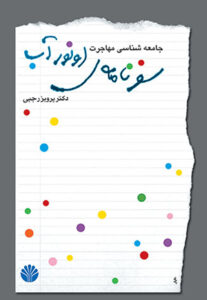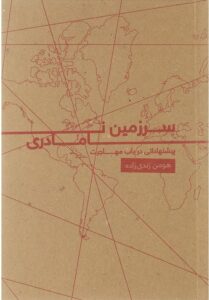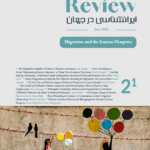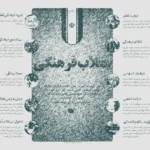From Travelogue to Novel: Representing Iranian Migration in Three Non-Academic Narratives (©Background)
/Book Review | Reading Time: 8 minutes
From Travelogue to Novel
Representing Iranian Migration in Three Non-Academic Narratives
Omid Asayesh | June, 2025

This article introduces and examines three distinct works that explore the experiences of Iranian migrants, each approaching the subject from a different angle. One is a narrative-driven novel, another a critical travelogue, and the third a guidebook intended to offer practical advice for Iranians considering migration. Despite their varied forms, all three books share a common feature: they are written for a general audience—readers who may not have academic expertise but are interested in migration, or who are simply drawn to stories and personal narratives. While academic literature on migration has expanded significantly in recent years, non-academic works like these can offer valuable insight into the lived and human dimensions of migration. For scholars and readers interested in the Iranian diaspora, engaging with such texts can be especially enriching. Of course, Persian-language migration literature extends far beyond these three titles, but their selection here is rooted in the critical lens they adopt, their reliance on personal accounts, and the thoughtful, quasi-ethnographic perspectives they bring to the topic.
The first book, “Berliniha” (Berliners), is a novel by Kaveh Fooladianasab, published in 2021, and based on interviews with over one hundred Iranian migrants living in Berlin. Drawing on this rich fieldwork, the author constructs a layered, cohesive, and literary narrative that captures the complexity of Iranian migrant life in Germany. The story unfolds in a way that immerses the reader in both the inner dilemmas of its characters and the broader social reflections on migration. Through a compelling and well-structured narrative, the novel engages readers in a deeply human story that is at once intimate and sociologically resonant. The main characters represent two distinct generations of Iranian migrants: an older generation that, in past decades, mostly came to Berlin as political refugees and still views the grandeur of Iranian culture and history through a lens of nostalgia and exile; and a younger generation raised on the dream of emigration, now confronting the ambiguous, often disillusioning realities of life in the West. The novel not only explores the contrast between these generations’ views on homeland, language, identity, and belonging, but also delves into the internal psychological struggles of the younger migrants—those who attempt to erase visible markers of their origins in an effort to be accepted as part of the host society, yet despite all these efforts, suffers from an identity crisis. In contrast, the older generation remains anchored in the past, surrounded by symbols of Iran, and often maintains a suspended or unresolved relationship with their new environment. The novel shows how some members of the younger generation distance themselves from newer or less “integrated” migrants in an effort to appear more “foreigner” or more “German.”
The book also addresses under-discussed themes such as conspiracy thinking and collective anxieties within the Iranian migrant community. Siavash, the main character in the novel, suffers from a kind of paranoia; he constantly suspects that other Iranians who approach him are trying to spy on him or extract information. According to the narrative, however, this anxiety is not merely a personal trait—it reflects a broader sense of mistrust that has taken root within segments of the Iranian diaspora. Alongside its personal narratives, the book incorporates historical, social, and even philosophical reflections, ranging from memories of Iran’s political past recounted by older exiles to broader meditations on exile, home, and the meaning of staying or leaving. Although first and foremost a novel with an engaging storyline, its deeper layers offer fertile ground for scholars of migration and diaspora studies. One could say that “Berliniha” is not merely a literary work, but also a meaningful attempt to bridge literature and the social sciences, an effort that makes it both a remarkable and influential contribution to contemporary migration narratives.
 The second book, “Safarnameh-ye Onvar-e Ab: JamehShenasi-ye Mohajerat” (travelogue of overseas: A Sociology of Migration), is a travelogue written by Parviz Rajabi and first published in 2010. Rajabi, best known for his historical writings on Iran and numerous translations, uses this work—based on a brief trip to Canada in the final years of his life—to share his observations on the Iranian diaspora in that country. Although the book’s subtitle refers to it as a “sociology of migration,” it is difficult to classify it as a sociological text in the conventional sense. A more accurate description might be found in the book’s main title: a “travelogue.” Yet this is not a travelogue in the usual sense—concerned with tourist sites or daily experiences—but rather a reflective account filled with the author’s observations on migration, the Iranian diaspora, and the idea of “the West” as contrasted with Iran. What sets this book apart is that it presents the experience of migration not from the perspective of a migrant, but through the eyes of a temporary visitor—someone with significant intellectual and social standing, who had the opportunity to meet and converse with a range of prominent figures in the Iranian-Canadian community. Rajabi’s portrayal of Canada is a blend of admiration and critique. While engaging with the dominant discourse in Iran that idealizes “abroad” as an utopia, he draws on his earlier years of living in Germany to push back against that idealization and offer a more grounded view of the West. This tension runs throughout the book: on one hand, he describes the West as a place where “expertise and seriousness come first” (p. 96); on the other, he warns against equating the “minor freedoms” found in the West with true liberty (p. 108). His ongoing effort to depict a nuanced and ambivalent picture of the West is occasionally punctuated by moments of visible admiration.
The second book, “Safarnameh-ye Onvar-e Ab: JamehShenasi-ye Mohajerat” (travelogue of overseas: A Sociology of Migration), is a travelogue written by Parviz Rajabi and first published in 2010. Rajabi, best known for his historical writings on Iran and numerous translations, uses this work—based on a brief trip to Canada in the final years of his life—to share his observations on the Iranian diaspora in that country. Although the book’s subtitle refers to it as a “sociology of migration,” it is difficult to classify it as a sociological text in the conventional sense. A more accurate description might be found in the book’s main title: a “travelogue.” Yet this is not a travelogue in the usual sense—concerned with tourist sites or daily experiences—but rather a reflective account filled with the author’s observations on migration, the Iranian diaspora, and the idea of “the West” as contrasted with Iran. What sets this book apart is that it presents the experience of migration not from the perspective of a migrant, but through the eyes of a temporary visitor—someone with significant intellectual and social standing, who had the opportunity to meet and converse with a range of prominent figures in the Iranian-Canadian community. Rajabi’s portrayal of Canada is a blend of admiration and critique. While engaging with the dominant discourse in Iran that idealizes “abroad” as an utopia, he draws on his earlier years of living in Germany to push back against that idealization and offer a more grounded view of the West. This tension runs throughout the book: on one hand, he describes the West as a place where “expertise and seriousness come first” (p. 96); on the other, he warns against equating the “minor freedoms” found in the West with true liberty (p. 108). His ongoing effort to depict a nuanced and ambivalent picture of the West is occasionally punctuated by moments of visible admiration.
Arguably, the most compelling aspect of the book is Rajabi’s documentation of everyday interactions with Iranian migrants in Toronto. Through a form of cultural observation similar to ethnographic sketching, he critically reflects on their ways of life in the host society. Throughout the book, the author repeatedly emphasizes that, at least for the first generation of Iranian migrants, the “quality of life” in Iran is higher than in the West, a view that, in his opinion, is unwelcome to many and may even lead to the speaker being condemned (p. 180). Identifying himself as someone emotionally attached to Iran, Rajabi frames Iranian migration not as a pursuit of Western opportunities, but as a form of displacement. His reflections are not limited to the Iranian community in Toronto; in several parts of the book, he draws on his own lived experience in Germany to generalize his observations to the broader Iranian diaspora. For instance, he recalls a conversation with the head of the immigration office in his German town, who remarked that, unlike other nationalities, Iranians don’t need “spies,” they “inform on each other voluntarily” (p. 152). These accounts, while not always precise or systematically presented, are nonetheless compelling and thought-provoking, precisely because they offer a documented portrayal of Iranian migrants’ lives through the lens of an Iranian traveller and researcher.
 The third book, “Sarzamin-e Namadari: Pishnahadati Dar Bab-e Mohajerat” (The Stepmotherland: Suggestions on Migration), written by Hooman Zandizadeh and published in 2015, is based on over seventy interviews with Iranians living in various countries. At the time of writing, the author himself was living in Australia. He asked each interviewee to share ten pieces of advice they would offer to a friend about to emigrate. As the author states, the book is not an academic study; rather, it is intended as a practical guide for those considering migration from Iran. Nevertheless, because it draws on conversations with a diverse group of Iranian migrants—and because the author himself speaks from personal experience—the book can serve as a valuable resource for researchers interested in migration studies. The book is divided into two main sections. The first focuses on the pre-migration stage in Iran, examining how migration has become a widespread social concern, what people expect from it, what motivates their decisions, how they choose destinations, and whether they view migration as a one-way path.
The third book, “Sarzamin-e Namadari: Pishnahadati Dar Bab-e Mohajerat” (The Stepmotherland: Suggestions on Migration), written by Hooman Zandizadeh and published in 2015, is based on over seventy interviews with Iranians living in various countries. At the time of writing, the author himself was living in Australia. He asked each interviewee to share ten pieces of advice they would offer to a friend about to emigrate. As the author states, the book is not an academic study; rather, it is intended as a practical guide for those considering migration from Iran. Nevertheless, because it draws on conversations with a diverse group of Iranian migrants—and because the author himself speaks from personal experience—the book can serve as a valuable resource for researchers interested in migration studies. The book is divided into two main sections. The first focuses on the pre-migration stage in Iran, examining how migration has become a widespread social concern, what people expect from it, what motivates their decisions, how they choose destinations, and whether they view migration as a one-way path.
The second section turns to the post-migration experience, aiming to outline the challenges many migrants encounter but may not anticipate—issues such as cultural dissonance, identity struggles, encounters with racism, and the hardships of settling into an unfamiliar society. By presenting these experiences, the author hopes to help prospective migrants develop more realistic expectations. From a critical standpoint, while the book touches on important topics, it rarely explores them in depth. However, given its purpose as an accessible resource for a general audience, the book’s straightforward language may in fact increase its reach and readability. For social scientists, the book may serve less as an analytical framework than as a documentary starting point, raising key questions and offering a foundation for further exploration. For example, the book explores common narratives and fears among Iranian migrants, such as the widely repeated advice to “stay away from other Iranians,” as well as more hidden anxieties about admitting failure, avoiding help-seeking, and fearing a return to the homeland. Although these issues are deeply present in the lived experiences of many migrants, they have received little attention in academic literature and could serve as important entry points for future research in the field of Iranian diaspora studies.
In sum, each of these three books—though stylistically distinct and written for a general audience—offers a critical lens through which to examine the complex experience of Iranians’ migration, from the hopes and uncertainties preceding departure to the cultural and social challenges encountered in the host country. The growing body of popular literature on migration in Iran reflects the extent to which migration has become a lived and cultural concern for a wide segment of society. Each of the three genres discussed here offers a distinct lens for analyzing migration: the novel, through its narrative power, immerses us in the inner world and emotions of migrants; the travelogue provides a reflective and critical view of personal encounters with migration and migrant communities; and the migration guide, though concise and practical in form, draws on interviews with a diverse range of migrants to offer grounded, field-based insights into the realities of migration from multiple perspectives.
In conclusion, it is important to note that these works are not necessarily intended as critiques of migration or migrant life. The more positive aspects portrayed in them have not been emphasized here, not because they are unimportant, but because this article does not aim to provide a comprehensive review of every dimension of these books. Rather, its focus has been on those moments that highlight social questions or provide opportunities for scholarly inquiry. These texts—particularly for readers with sociological concerns—gain analytical value precisely in those instances, even if brief or implicit, where they surface a tension, a gap, or a challenge. For example, Sarzamin-e Namadari repeatedly stresses that migration is a personal and non-generalizable experience—neither necessarily good nor inherently bad—and that in many cases, it can lead to valuable opportunities, and Safarnameh-ye Onvar-e Ab contains numerous expressions of admiration for Toronto’s architecture, urban order, and cultural diversity. While these elements are indeed part of each book’s narrative structure, they were not central to the present analysis. The primary aim here has been to highlight aspects that may be particularly relevant to migration and diaspora studies. From this perspective, engaging with such non-academic texts can not only open new avenues for research but also offer access to voices and experiences that often remain marginalized or unspoken in formal, data-driven, and academic literature.
1- Fouladinasab, Kaveh. (2021). Berliniha (Berliners). Cheshmeh Publications.
2- Rajabi, Parviz. (2019). Safarnameh-ye Onvar-e Ab: JamehShenasi-ye Mohajerat (travelogue of overseas: A Sociology of Migration). Ameh Book.
3- Zandizadeh, Hooman. (2015). Sarzamin-e Namadari: Pishnahadati Dar Bab-e Mohajerat (The Stepmotherland: Suggestions on Migration). Avazh Publications.








Comments are closed.